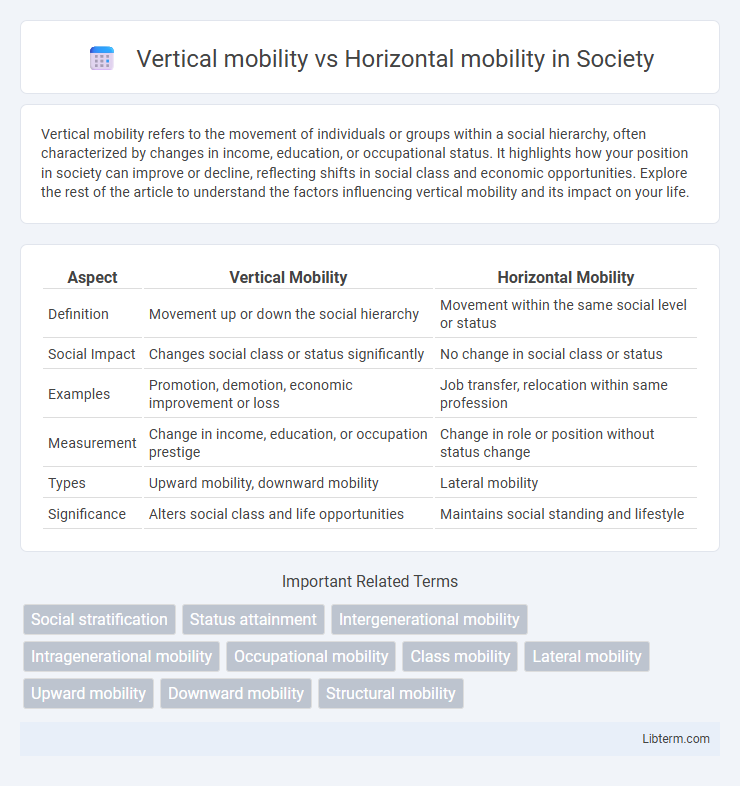Vertical mobility refers to the movement of individuals or groups within a social hierarchy, often characterized by changes in income, education, or occupational status. It highlights how your position in society can improve or decline, reflecting shifts in social class and economic opportunities. Explore the rest of the article to understand the factors influencing vertical mobility and its impact on your life.
Table of Comparison
| Aspect | Vertical Mobility | Horizontal Mobility |
|---|---|---|
| Definition | Movement up or down the social hierarchy | Movement within the same social level or status |
| Social Impact | Changes social class or status significantly | No change in social class or status |
| Examples | Promotion, demotion, economic improvement or loss | Job transfer, relocation within same profession |
| Measurement | Change in income, education, or occupation prestige | Change in role or position without status change |
| Types | Upward mobility, downward mobility | Lateral mobility |
| Significance | Alters social class and life opportunities | Maintains social standing and lifestyle |
Understanding Social Mobility: Vertical vs Horizontal
Vertical mobility refers to the movement of individuals or groups up or down the social hierarchy, often measured by changes in income, occupation, or social status, reflecting a shift in socioeconomic class. Horizontal mobility involves a change in position or role within the same social level, such as switching jobs within the same income bracket or relocating geographically without altering social status. Understanding social mobility requires analyzing these two forms to assess how economic, educational, and social factors impact individuals' opportunities for progression or lateral movement within society.
Defining Vertical Mobility
Vertical mobility refers to the movement of individuals or groups up or down the social hierarchy, often measured by changes in socioeconomic status, occupation, or class. It involves promotions, demotions, or shifts that alter one's social standing, contrasting with horizontal mobility, which denotes changes within the same social level. Vertical mobility is a key concept in sociology for understanding social stratification and economic opportunities.
Defining Horizontal Mobility
Horizontal mobility refers to the movement of individuals or groups within the same social or economic level without a change in status, job role, or income bracket. It typically involves shifts across similar occupations, workplaces, or social positions, maintaining a consistent level of power and prestige. Understanding horizontal mobility helps analyze career transitions and social dynamics that do not alter an individual's class or socioeconomic standing.
Key Differences Between Vertical and Horizontal Mobility
Vertical mobility involves the movement of individuals or groups up or down the social hierarchy, reflecting changes in social status such as promotions or demotions. Horizontal mobility refers to a change in position or occupation within the same social stratum, maintaining the same social status without significant impact on prestige or income. Key differences include the direction of social change, with vertical mobility indicating upward or downward shifts, while horizontal mobility represents lateral movement within the same social level.
Factors Influencing Vertical Mobility
Vertical mobility, the movement between different social strata, is influenced by factors such as education level, occupational opportunities, and social networks, which shape access to higher or lower socio-economic positions. Economic changes, including industrial shifts and labor market demands, also play a crucial role in enabling or restricting upward or downward social movement. Family background and social policies affect vertical mobility by either facilitating skill development and resource acquisition or reinforcing existing inequalities.
Factors Influencing Horizontal Mobility
Factors influencing horizontal mobility include educational attainment, occupation type, and industry shifts that allow individuals to move within the same social strata. Geographic relocation and changes in social networks also play a critical role by providing new opportunities without significant changes in social class. Economic conditions and organizational restructuring can impact job roles, enabling lateral moves across similar positions.
Social Implications of Vertical Mobility
Vertical mobility involves changes in an individual's social status either upward or downward, significantly impacting social identity and access to resources. Upward vertical mobility typically leads to improved economic opportunities, enhanced social networks, and greater political influence, while downward mobility can result in social exclusion, reduced self-esteem, and limited access to essential services. The social implications of vertical mobility shape community dynamics, often affecting social cohesion and contributing to stratification within societies.
Economic Effects of Horizontal and Vertical Mobility
Vertical mobility increases income disparities by enabling individuals to move up or down the socioeconomic ladder, impacting wealth distribution and economic growth patterns. Horizontal mobility shifts individuals within similar economic strata, often maintaining overall income levels but influencing job satisfaction and workforce adaptability. Both forms of mobility affect labor market dynamics, consumer spending, and social capital, shaping economic stability and development.
Real-World Examples: Vertical vs Horizontal Mobility
Vertical mobility involves individuals moving up or down the social or occupational hierarchy, such as a software engineer promoted to a managerial position in a tech company. Horizontal mobility occurs when a person changes jobs or roles within the same social status level, like a nurse switching from a hospital to a clinic without a significant change in rank or salary. Real-world examples include corporate employees climbing the ranks for vertical mobility, while teachers transferring between schools represent horizontal mobility.
Enhancing Social Mobility: Strategies and Challenges
Enhancing social mobility requires strategic interventions targeting both vertical and horizontal mobility, where vertical mobility emphasizes upward movement across social strata and horizontal mobility involves transitions within the same socioeconomic level. Effective strategies include improving access to quality education, vocational training, and equitable employment opportunities that break systemic barriers hindering upward progression. Challenges such as entrenched social inequalities, labor market rigidities, and limited intergenerational wealth transfer continue to impede these mobility efforts.
Vertical mobility Infographic

 libterm.com
libterm.com